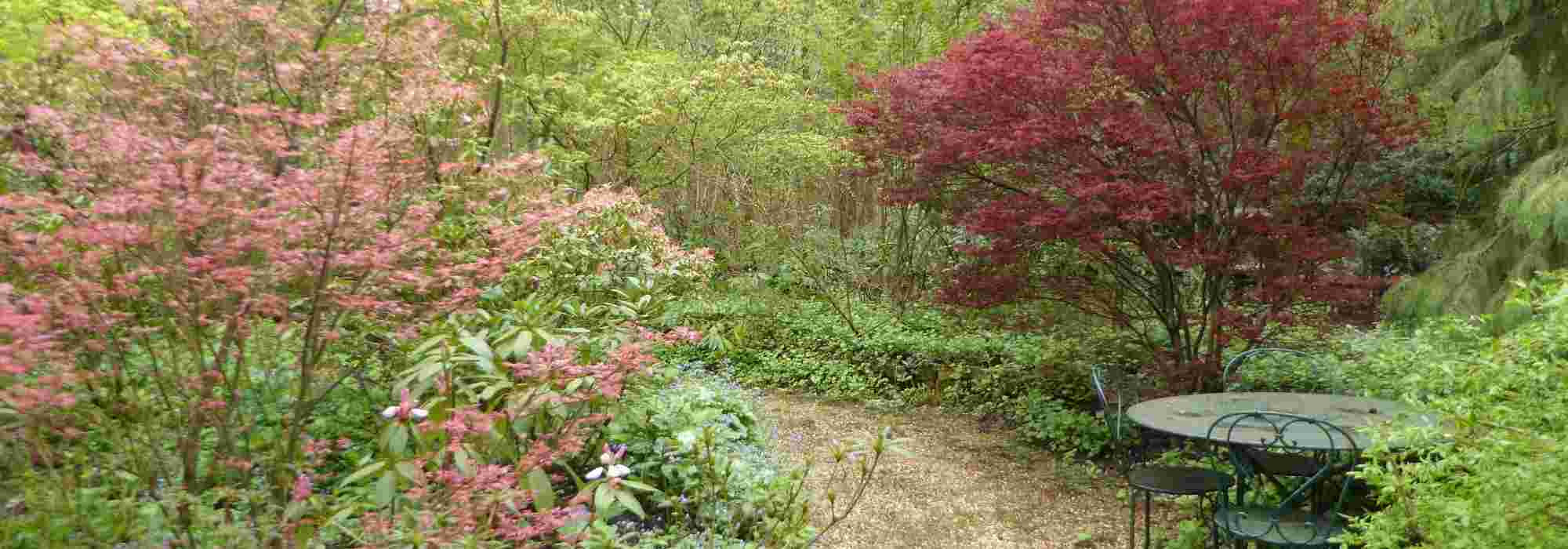
7 shrubs to line a path
A selection to add an original touch to your pathways
Contents
Garden paths are among garden’s structuring elements, often dressed by shrubs and perennials with their foliage and flowering. Edging a garden path is not as simple as it seems: you may want to elegantly highlight routes through your little green paradise, but between perennials, bushes of all kinds, small low clipped hedges, even trees for larger spaces, how do you choose and coordinate everything to achieve a pleasing look that is easy to maintain?
While your garden type, its size, path exposure, frequency of use, and soil will remain distinguishing criteria in your choice, it is important to skilfully compose with volumes and densities provided by different bushes, harmoniously mix evergreen and deciduous foliage, play with flowering, stagger blooms across seasons, and include some scented bushes… because your path is a frequently used thoroughfare, sometimes even leading directly to your house!
Short of inspiration? We offer a selection of small- and medium-sized bushes for very different garden styles and scenes, to edge your paths simply and harmoniously.

Country garden, exotic, French formal… different path styles for different types of bushes and plants
Spirea x arguta: graceful white lining a grassy path
A grassed path evokes holidays, fine days spent wandering the garden more often, country, informal or English-style gardens. On this type of charming, often gently curving path, it is interesting to compose with foaming shrubs and perennials that seem to invade the passage, possessing irregular, flexible, arching habits to create a wonderfully untidy vegetal effect!
White Spirea, or Spirea arguta, is a very handsome deciduous shrub about 1.5 m all round, with a rounded habit and shoots that are initially erect before becoming increasingly arching. It is particularly suited to a sunny or partially shaded romantic path. This spirea is one of the first to flower, between April and May; it then bears a profusion of very delicate inflorescences made up of small umbels of tiny pure white flowers. Its foliage, a lovely grey-tinged green, turns golden yellow in autumn.
Combine White Spirea with a few similarly arching shrubs such as Deutzias, Exochordas, Buddleias, and some Potentillas, Sages, Hypericum kalmianum ‘Blue Velvet’, Abelias to provide flowers through to autumn, and with shrubs that add a little height and rustic charm such as the elegant scented Clerodendron. Perennials and bulbous plants will inevitably feature in this path, and here the choice is endless: Iris, Delphiniums, Cosmos, Alchemillas, Gypsophilas, Asters…
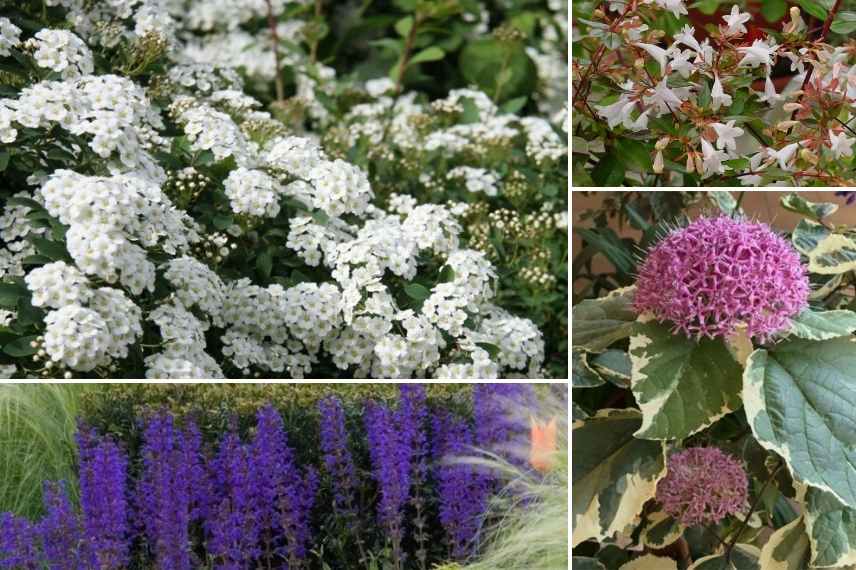
White Spirea, sage, Abelia and Clerodendron bungei ‘Pink Diamond’
Find our range of Spireas and consult our full sheet: Spirea: planting, pruning and maintenance.
Read also
Which plants to border a path?Hydrangea aspera sargentiana: spectacular along a broad, shady path
In a large garden with wide paths, choose shrubs that provide exuberance in silhouette, foliage and flowering to give sufficient presence along often long walks. In shady to semi-shady positions, Hydrangeas make very attractive subjects for lining a path.
Hydrangea aspera sargentiana is spectacular for its long downy leaves, slightly greyed. Its flowering begins in July, forming large flattened inflorescences, old-rose almost mauve on the fertile flowers and highlighted by the large white petals of the sterile flowers. Although flowering over a relatively short period, its almost exotic-looking foliage, and its bushy habit really lend themselves to creating a lovely atmosphere along a long shaded path.
Pair it with a collection of Hydrangeas, and with evergreen shrubs of similar or smaller height that will flower at different times, in white and pink tones: in spring Pieris, a Gardenia jasminoides ‘Summer Snow’ with a powerful fragrance, some Daphnes also fragrant used as groundcover, Rhododendrons, a Japanese Azalea ‘Amonea’, some Sarcococcas confusa in winter, etc…

Hydrangea aspera sargentiana, accompanied by a Gardenia jasminoides ‘Summer Snow’ and Pieris ‘Flaming Silver’
Find our range of Hydrangeas aspera and consult our full fact sheet: Hydrangeas: planting, pruning and care.
Acer palmatum 'Orange Dream': Japanese-style planting on a gravel path
If your garden leans towards Japanese style, Japanese maple is shrub of choice to maintain that contemplative atmosphere combining vertical and horizontal plants, as well as very varied shapes, heights, colours and textures.
Acer palmatum ‘Orange Dream’ is a superb, open-shaped Japanese maple, remaining small (usually 2 m tall), able to suit a small or slightly larger Japanese garden. Planted as a solitary specimen along a shaded path, it really stands out and brings a refined Japanese touch. Its palmate foliage is especially striking with subtle, changing hues: bright red-edged yellow giving an almost coral effect in spring, then yellow-green in summer, finishing orange-red in autumn. Every season with it is a delight!
With Acer palmatum ‘Orange Dream’, adopt a rather restrained planting plan, without trying to fill the path, instead planting very carefully chosen plants that will be highlighted: Pleioblastus, Nandinas for winter foliage interest, Skimmias japonica, dwarf conifers, a fragrant azalea or a Japanese cherry for a splash of colour, an Ilex crenata cloud-pruned…
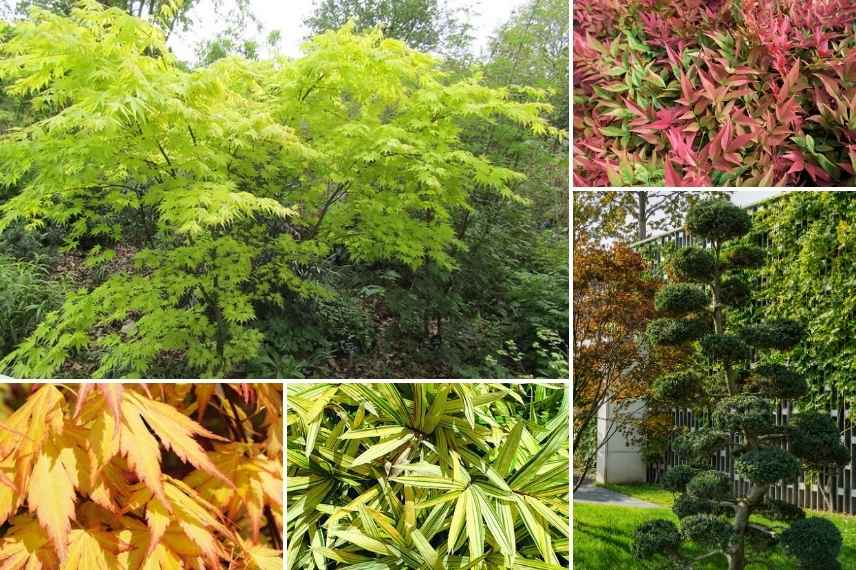
Find our range of Japanese maples and consult our full page: Japanese maple: planting, pruning and maintaining.
Salix rosmarinifolia: swaying along a wild lane
In a large naturalistic garden, using bushy shrubs to create natural, wild atmospheres is appealing. The Salix rosmarinifolia forms a compact clump that is both very airy and graceful, ideal for lining long paths that disappear into the landscape. Its very fine foliage, lanceolate, is dark green above and white and felted beneath, giving a silvery aspect that yellows in autumn before dropping. Brown-red bark is also striking. Planted in a sunny position, in dry to moist soil, it will reach about 1.50 m in height, and will need little maintenance on a distant, wild garden path or in a natural meadow where a few walkways are created. It is also suitable for a large garden by the sea.
To stroll along this wild path, pair it with fragrant or aromatic plants with a loose habit, such as Perovskias atriplifolias. Give it some wild herbs that will accompany it beautifully, such as tall grasses (Miscanthus, Panicums…), decorative wood dogwoods, etc…
See our full factsheet: Willow, Salix : plant, prune and maintain.
Cycas: strikingly graphic for an exotic avenue
Bordering a small straight-lined path in an exotic garden context, a row of Cycas revoluta takes on a very graphic, even Mediterranean, look that refreshes the genre.
The Cycas revoluta is an evergreen plant resembling a palm that has great character with its glossy, dark green, pinnate foliage arranged in a rosette. Its very slow growth makes it a perfect subject along an avenue, which will require little maintenance in mild climate.
This kind of “Cycas avenue” also works perfectly in a contemporary, modernist or even urban garden, where, in cooler climates, they can even be placed in matching containers and put into storage for winter. Cycas grown under these conditions will remain modest in size.
The resolutely contemporary look is achieved with Cycas planted in linear fashion, but if you wish, you can alternate or replace them with other shrubs with globe or spherical habit that are just as graphic, of varying heights and with foliage in different shades of green: Cordylines, bluish Dasylirions , Yucca rostrata… or Pittosporum tobira ‘Nanum’ to add the missing fragrance to this scene.
See our full fact sheet: Cycas: planting and care.
Dwarf Weymouth Pine: for a steep rockery-style path
A sloping path often brings much character to a garden space, whether it lies at the heart of a secret area or leads to the house entrance. Because of the topography, plants planted higher up will be better drained than those at the bottom of the path.
Low shrubs with a habit tapetum such as Pinus strobus ‘Minuta’ (dwarf Weymouth pine) fit delightfully on this type of path, especially when mixed with other evergreen subjects in a rock-garden spirit…This small globe pine (60 by 90 cm) grows slowly, its bluish foliage is superb, and its flattened, very tidy habit will require little maintenance.
As with other paths, favour a few scented shrubs or perennials that will add to the pleasure of walking this route: dense cushions of Abies balsamea ‘Nana’ with spicy scent, a myrtle to add a little volume and a delicate fragrance. The yellow of a Dyer’s greenweed and the white of heathers integrate very well, as does Berberis thunbergii ‘Tiny Gold’ with its contrasting acid-green foliage, or a dwarf creeping cherry. This type of composition, of course, works very well in an alpine garden!
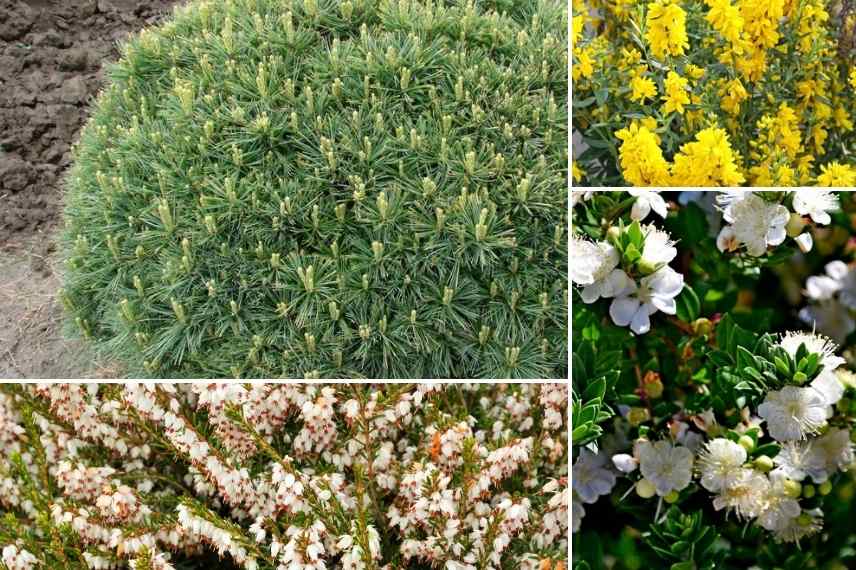
Pinus strobus ‘Minuta’, white heather, Genista tinctoria ‘Plena’, Myrtus communis ‘Tarentina’
Find our range of pines and all our advice to succeed in their cultivation: Pine, Pinus: planting, pruning and care.
Buxus microphylla 'Faulkner': a must for classic gardens
Straight, rectilinear paths best symbolise classic, formal gardens or, conversely, contemporary gardens. To emphasise these geometric lines, low clipped blocks of greenery are ideal!
Boxwood immediately comes to mind, admittedly battered in recent years by the infamous box tree moth… But it’s still possible to keep attractive low small hedges by giving them appropriate care, over short stretches of path, for example in urban gardens or small modernist gardens. For this use, the Buxus microphylla ‘Faulkner’ is very elegant and hardy, with glossy dark green foliage. It is a compact shrub, very suited to repeated pruning, which grows slowly, like all boxwood. It is truly the shrub of choice, highly decorative to place in a small space with clean, geometric lines.
You might also add a few standard-trained topiaries, planted or in pots, such as Ligustrum delavayanum, or Laurus nobilis (bay laurel trained as a standard) to reinforce the very classic character produced by boxwood, and to add verticality. If you are wary of using boxwood, feel free to replace it with certain dwarf varieties of Euonymus japonicus ‘Microphyllus’ or with crenate holly!
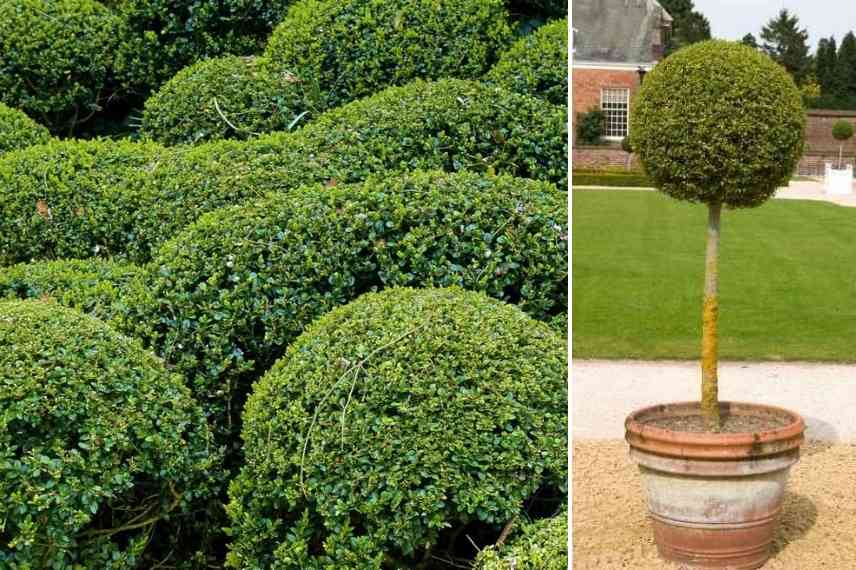
Buxus microphylla ‘Faulkner’ and a privet standard
Discover our range of boxwood and our full fact sheet Boxwood: planting, pruning, maintenance
- Subscribe!
- Contents
































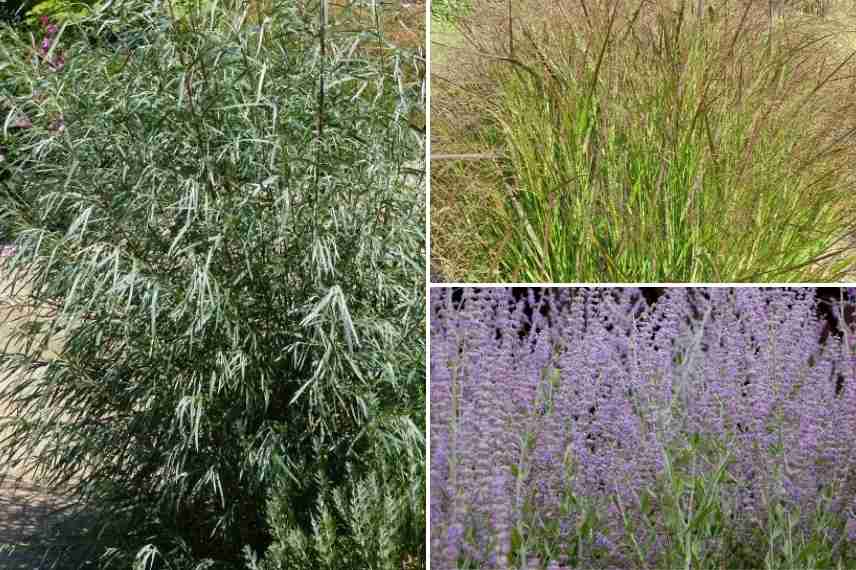

Comments